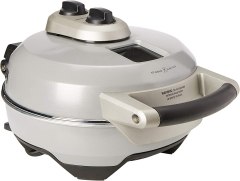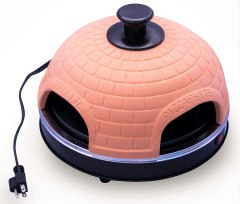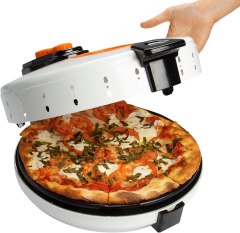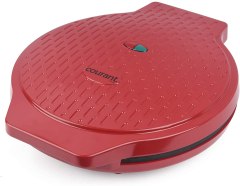BestReviews is reader-supported and may earn an affiliate commission. Details

If you want to cook the best pizza possible, the brick oven-level heat of this option really delivers.
Comes in your choice of red or gray finish. Top and bottom elements heat up to 660°F, simulating a brick oven. Settings for thin, medium, and thick crusts. Will fit up to an 11-inch pizza. Solid, well-made oven. Cooks a pizza in 6 to 10 minutes.
Top element is too low, so thick crust or toppings can burn. Has a chemical smell initially.

This oven has a cool factor that makes cooking a pizza fun, especially for kids.
Pizza takes about 15 minutes to cook. Also works for a variety of other foods, from chicken fingers to s'mores. Easy to clean and store. Top and bottom heating elements work separately for full control over cooking. Nice design.
Gets surprisingly hot, so use with caution. Pizza doesn't get hot enough for some. Has a break-in smell at first.

This tabletop pizza oven is fun for all ages — though there's a bit of a learning curve.
Fun for family get-togethers and parties. Unit takes 5 minutes to heat up, 10 minutes to cook. Fits up to six small pizzas at a time. Easy to set up and clean.
Takes some trial and error to get good results. Some say it cooks pizzas unevenly.

A rotating, double-heating countertop pizza maker for baking or reheating pre-made and frozen pizzas.
The nonstick baking surface rotates for even heating, while heating elements above and below, ensure that toppings and crust are cooked. A viewing window lets you keep an eye on your pie. Has a 30-minute timer and three heating levels.
Extra-toppings or thick crust can crowd the upper element. Not ideal for cooking from scratch.

This simple countertop pizza maker can cook frozen pizzas and other foods to a crisp and our cooking expert likes that it's easy to store vertically.
Top and bottom nonstick heating surfaces cook pizzas and other foods to crispness with a 1440-watt heating surface. Wipes clean with a paper towel or damp cloth. Stores vertically to save space.
No controls other than on/off switch. Heating surface does not rotate.

We recommend these products based on an intensive research process that's designed to cut through the noise and find the top products in this space. Guided by experts, we spend hours looking into the factors that matter, to bring you these selections.

It’s hard to top the taste and freshness of a pizzeria pizza but buying takeout pizza once a week soon adds up. With an indoor pizza oven at your disposal, you can learn to make pizzas every bit as delicious as those from your favorite pizzeria. Not only will this save you money, you can tailor your pizzas exactly how you like them, experiment with toppings, and try a range of pizza styles.
Indoor pizza ovens need the right cooking surface and well-positioned heating elements for the best results. A quality indoor pizza oven must reach a high internal temperature; otherwise, you might as well use your regular oven and a pizza stone. Size is important, too: most folks agree the right pizza oven is large enough to accommodate a decent-size pizza but not so large that it takes up the entire countertop.

The cooking surface of a pizza oven is also known as the deck. An oven with a stone deck replicates that of a traditional brick floor pizza oven. It heats evenly, and the porous base draws moisture out of the base, resulting in a crisp crust without sogginess. Some users don't like the fact that stone cooking surfaces can stain and seem tricky to clean. However, all you need to do is scrape off any stuck-on food after use, and the high heat of the oven will keep them sanitary.
Thick steel cooking surfaces work about as well as stone decks, but these should be at least 0.15 inches thick to retain enough heat to make the base sufficiently crisp. If you’re on a tight budget, you could consider a pizza oven with a nonstick coated cooking surface. However, a nonstick surface would most likely scratch and peel over time.
For the ultimate results, a pizza oven needs both top and bottom heating elements. The bottom heating element helps crisp up the underside of the pizza while the top element ensures your toppings cook to perfection and the crust is just right. Although this is usually only an option with high-end indoor pizza ovens, you should ideally be able to control the top and bottom heating elements independently. Occasionally, you'll find your toppings and crust are cooked while the underside is still too pale, or the underside is overly charred while the top of your pizza still needs more cooking time. A pizza oven with independently controlled top and bottom heating elements allows you to work around this issue.
What makes an indoor pizza oven stand apart from other ovens is the high maximum temperature. The average home oven only reaches 450°F, while quality indoor pizza ovens reach between 550°F and 800°F. Bear in mind that a wood-fired oven used to cook Neapolitan pizzas should reach roughly 750°F on the cooking surface and 900°F in the dome, whereas New York pizzas are usually cooked at somewhere between 550°F and 600°F.
Indoor pizza ovens are designed to be used on the countertop, so most are around the width of a toaster oven or a large microwave, but they may not be as tall. The exterior dimensions are less important than the interior dimensions. At the very least, an indoor pizza oven should accommodate an 11-inch or 12-inch pie, but you can find large models that make pizzas up to 14 or 16 inches in diameter. Consider your preference for pizza size before you buy.

Some pizza ovens have thermostats that allow you to set a precise temperature. Others simply have low, medium, and high settings, so it's more of a guessing game. Either way, we recommend buying a laser thermometer to check the temperature inside the oven.
You can find pizza ovens with built-in timers so you don't accidentally leave your pizza in too long. It's not an essential feature, however, since you could also use a kitchen timer, the timer on your oven, or the timer on your phone.
High-end indoor pizza ovens occasionally have built-in settings for different types of crust, such as New York, Chicago, or Neapolitan. This means it doesn't matter if you don't know the right temperature settings at which to cook various styles of pizza — the oven does the work for you.
When transferring your uncooked pizza to your pizza oven, use a thin layer of semolina on the peel to prevent sticking.
The least-expensive indoor pizza ovens cost between $50 and $200. However, the majority of those under $100 don't produce results that are much better than a standard oven.
To get a mid-range pizza oven that can produce restaurant-quality results with little practice, expect to pay between $200 and $500.
The priciest indoor pizza ovens cost between $500 and $1,000. These reach extremely high temperatures and make pizzas as good as you'd get from a pizzeria with minimal effort. They may have a larger capacity than average or useful extra features.


A. The first obvious difference between a home indoor pizza oven and a commercial indoor pizza oven is the size. The majority of home pizza ovens are freestanding and designed to fit on a countertop, while commercial pizza ovens are more likely to be built-in and the size of a conventional oven or larger. Home indoor pizza ovens can usually only cook one pizza at a time, whereas commercial pizza ovens can cook multiple pizzas at once, which is a necessity in a pizzeria kitchen. You also have more fuel options with commercial indoor pizza ovens — home indoor pizza ovens are almost exclusively electric while commercial options can also be gas-powered, wood-fired, or even coal-fired.
A. Indoor pizza ovens generally cook at least 150 to 200 degrees hotter than standard ovens, giving pizzas a crispy base and light interior that you'd struggle to get from a regular oven. When you cook pizza in a regular oven at full temperature, the toppings often start to burn, and the top of the crust may darken too much before the underside of the base has become sufficiently crisp. If you cook at a lower temperature to prevent the top of the pizza from cooking too quickly, the whole pizza can dry out rather than having a soft, light interior. Basically, you get better results from an indoor pizza oven, which can rival restaurant-quality pizza.
A. You can cook most types of thin-crust pizza in an indoor pizza oven, such as New York and Roma pizzas. Some indoor pizza ovens can also accommodate thick-crust pizzas such as Chicago and general deep-dish pizzas. Although Neapolitan pizza technically must be cooked in a wood-fired oven, you can make something close to a Neapolitan pizza if your indoor pizza oven reaches 750°F or more.
Get emails you’ll love.
Learn about the products you’re wondering if you should buy and get advice on using your latest purchases.
